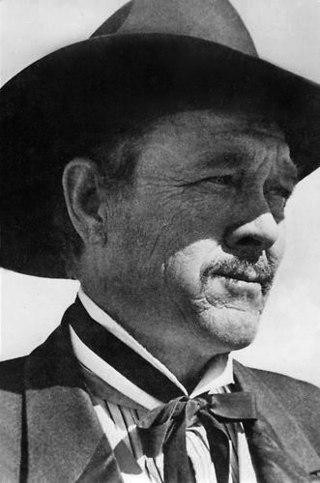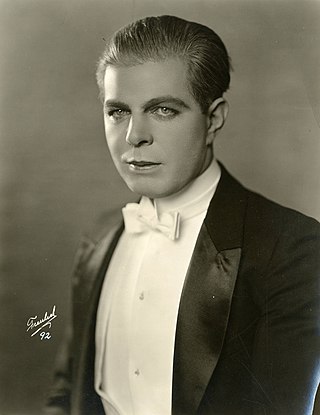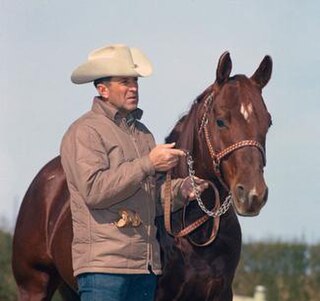Related Research Articles

Francis Benjamin Johnson Jr. was an American film and television actor, stuntman, and world-champion rodeo cowboy. Tall and laconic, Johnson brought authenticity to many roles in Westerns with his droll manner and expert horsemanship.

Willie M. Pickett was an American cowboy, rodeo performer, and actor. In 1989, Pickett was inducted into the ProRodeo Hall of Fame.

Edmund Richard "Hoot" Gibson was an American rodeo champion, film actor, film director, and producer. While acting and stunt work began as a sideline to Gibson's focus on rodeo, he successfully transitioned from silent films to become a leading performer in Hollywood's growing cowboy film industry.
Western lifestyle or cowboy culture is the lifestyle, or behaviorisms, of, and resulting from the influence of, the attitudes, ethics and history of the American Western cowboy. In the present day these influences affect this sector of the population's choice of recreation, clothing, and consumption of goods.
Earl Wesley Bascom was an American painter, printmaker, sculptor, cowboy, rodeo performer, inventor, and Hollywood actor. Raised in Canada, he portrayed in works of fine art his own experiences of cowboying and rodeoing across the American and Canadian West. Bascom was awarded the Pioneer Award by the ProRodeo Hall of Fame in 2016 and inducted into several halls of fame including the Canadian Pro Rodeo Hall of Fame in 1984. Bascom was called the "Cowboy of Cowboy Artists," the "Dean of Rodeo Cowboy Sculpture" and the "Father of Modern Rodeo." He was a participant member of the Church of Jesus Christ of Latter-day Saints.
Cody Lambert, is an American former professional rodeo cowboy. He specialized in saddle bronc riding and bull riding. He was also a co-founder and vice president of the Professional Bull Riders (PBR). He created the protective vest that professional bull riders have been required to wear for many years, after witnessing the death of his friend, Lane Frost at the Cheyenne Frontier Days rodeo in Cheyenne, Wyoming, on July 30, 1989. Since 2022, Lambert has been the head coach of the Texas Rattlers during the PBR Team Series season.

Stanley Davis Jones was an American songwriter and actor, primarily writing Western music. He is best remembered for writing "Ghost Riders in the Sky".
Poco Bueno was a brown American Quarter Horse stallion foaled April 10, 1944. He was sired by King P-234 and out of the mare Miss Taylor who was by Old Poco Bueno. Poco Bueno was named for his maternal grandsire, and the name means pretty good in Spanish. Poco Bueno is the stallion that is linked to the genetic disease Hereditary Equine Regional Dermal Asthenia (HERDA) in stock horses.
The American Quarter Horse Hall of Fame and Museum was created by the American Quarter Horse Association (AQHA), based in Amarillo, Texas. Ground breaking construction of the Hall of Fame Museum began in 1989. The distinction is earned by people and horses who have contributed to the growth of the American Quarter Horse and "have been outstanding over a period of years in a variety of categories". In 1982, Bob Denhardt and Ernest Browning were the first individuals to receive the honor of being inducted into the AQHA Hall of Fame. In 1989, Wimpy P-1, King P-234, Leo and Three Bars were the first horses inducted into the AQHA Hall of Fame.
Clabber (1936–1947) was a Quarter Horse stallion known as the Iron Horse for his ability to run and win match races after a day of ranch work.
Warren Granger "Freckles" Brown was a hall of fame American rodeo cowboy from Wheatland, Wyoming. His career spanned from 1937 to 1974, competing in bull riding, saddle bronc riding, bareback bronc riding, team roping, and steer wrestling. He was the World Bull Riding Champion in 1962. Brown was inducted into the ProRodeo Hall of Fame in Colorado Springs, Colorado, for bull riding in 1979. He was also inducted into the inaugural class of the Bull Riding Hall of Fame in Fort Worth, Texas, in 2015. Brown was most famous for riding Tornado, who had an undefeated record of 220 riders. Brown was also a close friend and mentor of Lane Frost.

Matlock Rose, born Berry Matlock Rose (1924–2008), was a professional horse trainer for over 60 years. He established a reputation as an all-around cowboy and trainer of champions. Rose was often described as stonefaced, a man of few words, but long held the respect of his peers. He was referred to as a trainers' trainer, and considered a legend. He trained multiple AQHA world champions, five NCHA world champions, was inducted into the American Quarter Horse Hall of Fame in 2001, as well as both the NCHA Rider Hall of Fame and the NCHA Members Hall of Fame. The first famous cutting horse he trained was Jesse James and many other great horses followed but he was best known for training Peppy San and Peponita.

Louis M. Pearce Jr. was an American businessman and rancher known for leading the Houston Livestock Show and Rodeo.

Fern Sawyer was an American cowgirl, rodeo champion, politician and inductee into the National Cowgirl Museum and Hall of Fame and the Rodeo Hall of Fame of the National Cowboy and Western Heritage Museum. She was the first woman to win the cutting horse competition at the 1945 Fort Worth Fat Stock Show and Rodeo. Sawyer was also the first woman appointed to the New Mexico State Fair Board. She was well known for her "flashy attire," according to the Santa Fe New Mexican. She lived in Crossroads, Lovington, and Nogal, New Mexico. She was also a charter member of the National Cutting Horse Association and the first director of the Girls Rodeo Association.
Guy Allen is an American ProRodeo Hall of Fame cowboy and an 18-time steer roping world champion. He competes in rodeos sanctioned by the Professional Rodeo Cowboys Association (PRCA). He won the world title for the steer roping event 18 times when competing at the National Finals Steer Roping (NFSR) and also won the National Finals Rodeo (NFR) Average title five times. He had won the title 11 times in a row when Buster Record broke his streak. Allen is also inducted into eight rodeo halls of fame.
Deborah Copenhaver Fellows is an American sculptor known for her Western themed works. Her best known work is the life-sized statue of former Arizona senator Barry Goldwater included in the National Statuary Hall Collection in the U.S. Capitol in Washington D.C. It was added to the collection as one of Arizona’s two statues in 2015.

Gina McDougall was a U.S.-born Canadian sculptor, rancher and horse trainer. She was a 2-time Canadian barrel racing champion in 1962 and 1963. The Calgary Stampede and Red Deer Silver Buckle Rodeo commissioned bronzes from her, and she had pieces in the private collections of Queen Elizabeth, Princess Margaret, and Randy Travis. She was inducted into the Calgary Stampede Western Art Show Hall of Fame in 2007 and the Canadian Pro Rodeo Hall of Fame in 2013.

Isabella Miller was a Canadian rodeo cowgirl, rancher and horse trainer. She was the Canadian barrel racing Champion in 1960 and 1969 and was a 5-time winner of the Canadian All-Around women's title. She was inducted into the Canadian Pro Rodeo Hall of Fame in 2005.
Rayel Robinson is a Canadian horse trainer and barrel racing champion. She won the Canadian Barrel Racing Championship in her sport in back-to-back wins in 1990 and 1991, and repeated in 1999 and 2005. She was reigning champion of the Ponoka Stampede in 2005, 2006, and 2007. She trained Tia, the horse who was awarded the Most Heart designation of the Canadian Finals Rodeo in 1991 and 1992 and in a single year had five horses that she trained qualify for the Canadian Finals Rodeo. She was inducted into the Canadian Pro Rodeo Hall of Fame in 2017.
The Schilling Ranch Historic District is a tiny portion of a historic ranch in Cochise County, Arizona which was listed on the National Register of Historic Places in 2009. It consists of several structures built in the early to mid-1900s. It is representative of the infrastructure required by cattle ranching operations in the Southwestern United States. It was used as a central location for cattle roundups from the surrounding cattle ranches, before shipment to the Willcox cattle auctions.
References
- ↑ "National Register of Historic Places - Registration Form". National Park Service. June 30, 2009. p. 11. Archived from the original on October 24, 2021. Retrieved January 12, 2023.
- ↑ "Ranching Is Only 1 Field of 82-Year Life". Arizona Daily Star . August 6, 1981. pp. H1-2. Retrieved January 13, 2023– via Newspapers.com.

- ↑ "Top Arizona Horse, Riders Are Named at Annual Show". Arizona Republic . November 13, 1967. p. 31. Retrieved January 13, 2023– via Newspapers.com.

- ↑ "Names in the News". Arizona Daily Sun . February 22, 1991. p. 19. Retrieved January 13, 2023– via Newspapers.com.

- ↑ "Goldwater Picked For Cowboy Hall". Tucson Citizen . March 18, 1991. p. 15. Retrieved January 13, 2023– via Newspapers.com.

- ↑ "J. Ernest Browning". American Quarter Horse Association. Archived from the original on October 18, 2022. Retrieved January 13, 2023.